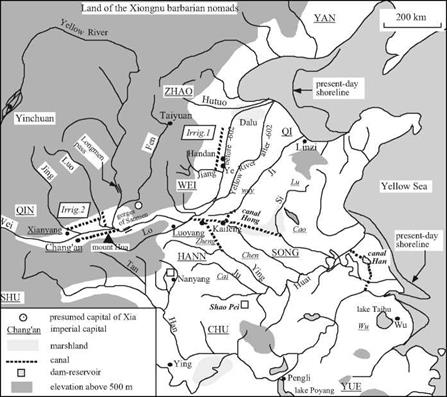From fear of the Yellow River to the first grand irrigation projects (7th to 5th centuries BC)
The first large dike construction projects on the lower course of the Yellow River date from the spring and autumn period, more precisely the first half of the 7th century BC. The duke Huan de Qi is said to have brought together the “nine rivers” described by Sima Qian into a single course and probably tried to drain the swampy plain.[388] Soon after came the first realignment of the river course mentioned in Chinese history. In 602 BC the river adopted a new course some hundred kilometers to the east (Figure 8.2). Fortunately, the region affected by this first event was probably not very populated. The north of the alluvial plain does not begin to see real development until the beginning of the warring states period (in the 5th and 4th centuries BC) when the Qi enters a new era of great prosperity. This will become one of the most active agricultural regions under the Qin and the Han.
The Yellow River is intensely present in Chinese thought during the feudal period; it is worshipped like a god. In some places a young girl is sacrificed to the river each year, such as at Ye, on the ancient course of the river that flows toward the north[389] in the Handan region (Figure 8.3). The girl is chosen by witches of the cult of the river, adorned as for marriage, placed on a wedding bed, then launched onto the river where the bed floats for a brief time, then sinks to drown the sacrificial maiden.[390] A certain Ximen Bao, a disciple of Confucius, was responsible for ending this practice. This end occurred under the enlightened reign of the duke Wen of the Wei kingdom (424 – 387 BC), a period during which this kingdom reached its apogee. We cannot resist the temptation to share the account of this event:
“Ximen Bao, having arrived in Ye, called together the notables and asked to learn about the custom that was desolating the county; marrying girls to the Lord of the River; the ceremony was described to him; he asked that he be told, without fail, of the day the festival would take place. When the day came, he and his soldiers went to the site of the sacrifice and announced that he came to be sure that a beautiful girl was chosen for the Lord. He looked at the girl chosen for sacrifice and declared to the grand wizard and to the elder of the country that the girl was not at all beautiful: he then sent the wizard to warn the Lord of the River that there was a mistake, that another would be chosen and that the ceremony was put off. The soldiers then threw the grand wizard into the river. Ximen Bao waited for a moment and, when the grand wizard did not come back from his mission, he threw an apprentice wizard into the river, then, when he did not return, a second apprentice, and finally a third. He then had the elder thrown into the river, and he did not return either. [….] Ximen Bao
|
Figure 8.3 The basins of the Yellow River and the Blue River, from the time of the Warring States up to the early Han Empire. The underlined upper-case names refer to these states after 350 BC. The underlined names in italics refer to the regions, more ancient, of the Spring and Autumn period. Grand irrigation projects of the feudal period: Irrig 1: between the Jiang and the Yellow Rivers (Ximen Bao) Irrig 2: Zhengguo canal and derivation canals (Zheng Guo) Irrig 3: Min basin – Figures 8.5 and 8.6 (Li Bing) |
then stopped the ceremony and no one dared speak of resuming it.”[391]
Ximen Bao is also known for the development of irrigation in the Ye region, on the lower slopes of the Thaihang mountains. Around 410 BC he had dug what amounts to a canal fed by the Jiang (an earlier tributary of the Yellow River), rising toward the northeast on a course parallel to and above that of the ancient bed of the Yellow River. Secondary canals then provided for gravity irrigation of all the region between this derivation and the Yellow River, a region that becomes particularly prosperous according to Sima Qian.[392]
Further to the south the first dam-reservoir known in China is constructed around 585 BC, in the state of Chu. It is intended to support irrigation, and is attributed to the minister Sun Shuao. The earthen dam is reinforced with layers of straw and wooden stakes. The dam was originally called the Shaobei (dam of the Peony flower), but it is known today as the Anfengtang, for it is still in service. It blocks a large valley of rather gradual relief into which flow two southern tributaries of the Huai, coming down from the mountains that separate the valley of the Hua from that of the Yangtze.[393] [394]







Leave a reply